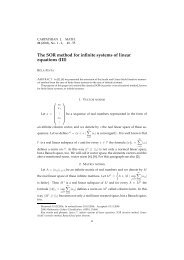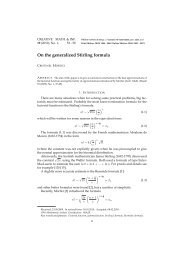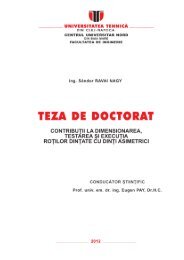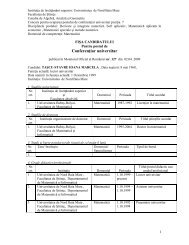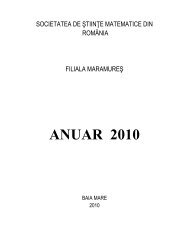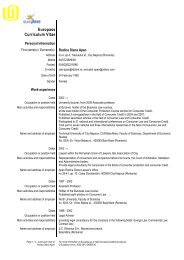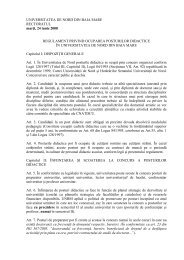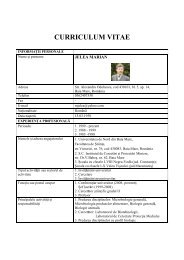Vol 3 (1) 2011 - UBM :: Departamentul de Chimie-Biologie
Vol 3 (1) 2011 - UBM :: Departamentul de Chimie-Biologie
Vol 3 (1) 2011 - UBM :: Departamentul de Chimie-Biologie
You also want an ePaper? Increase the reach of your titles
YUMPU automatically turns print PDFs into web optimized ePapers that Google loves.
M. Ayaz Javed, M. Na<strong>de</strong>em, Development of probiotics ice cream in Pakistan from buffalo milk by using<br />
B. bifidum and L. acidophilus<br />
resistance as compared to L. acidophilus.<br />
These results might be due to less acid<br />
production property of B. bifidum. The<br />
melting resistance of ice cream was<br />
<strong>de</strong>creased by increasing concentration of<br />
bacteria. Kebary [15] Studied the viability of<br />
B. bacterium bifidum and its effect on<br />
quality of frozen Zabady (frozen <strong>de</strong>ssert)<br />
and reported that all the samples had nearly<br />
the same melting resistance.<br />
L. acidophilus and B. bifidum both were able<br />
to grow and produce acid during<br />
fermentation in ice cream mix (Hekmat and<br />
McMahon [16]. At 0 day (-18 ºC), 0 day the<br />
total number of colonies counted were 10 5<br />
cfu/ml in ice cream samples inoculated with<br />
treatment T1, T4 and 10 6 in case of T7.<br />
Treatments T2, T5 and T8 showed<br />
comparatively better colonies i.e., 10 8<br />
cfu/ml. T3, T6 and T9 showed maximum<br />
number of bacteria i.e., 10 9 cfu/ml. The<br />
probiotic culture ad<strong>de</strong>d in combination i.e.<br />
treatments T7, T8 and T9 showed results<br />
close to treatments having single culture.<br />
The reason might be nutrients competency<br />
for both bacteria. Nutrients requirements for<br />
B. bifidum is more than L. acidophilus [17].<br />
Storage at -18ºC showed gradual <strong>de</strong>crease in<br />
number of bacteria. First reduction was<br />
observed after 45 days. There was total<br />
reduction of approximately 3 log cycles in<br />
case of L. acidophilus whereas, viability loss<br />
was observed only 1 log cycle for<br />
Bifidobacterium bifidum in the total<br />
experimental duration of ninety days.<br />
Hekmat and McMahon [16] observed in<br />
their studies that the viability of L.<br />
acidophilus in a standard ice cream mix<br />
<strong>de</strong>creased by 2 log cycles after storage for<br />
17 weeks at -29 ºC. In addition to that, more<br />
viability loss was observed in case of L.<br />
acidophilus which may be due to its more<br />
acid production property than Bifidum. The<br />
<strong>de</strong>cline in viable bacterial count during<br />
freezing step is most likely to be due to<br />
actual freezing of the cells that caused <strong>de</strong>ath<br />
of some cells. However, the mechanical<br />
stresses of the mixing and freezing processes<br />
and also oxygen incorporation into mix may<br />
have resulted reduction in viable bacterial<br />
count. Similar results were reported by<br />
earlier studies [18, 19, 20]. It was also<br />
observed that after 15 and 45 days of storage<br />
no <strong>de</strong>crease was found in viable count.<br />
However, a <strong>de</strong>crease in viable count was<br />
observed during 45 to 90 days of storage at -<br />
18 ºC, present study can be conclu<strong>de</strong>d as ice<br />
cream can serve as a good mean for<br />
<strong>de</strong>livering probiotic bacteria to the<br />
consumer. B. bifidum and L. acidophilus<br />
exhibited approximately similar properties.<br />
Level of probiotic bacteria used in treatment<br />
T3, T5 and T6 was found more appropriate<br />
in making ice cream a probiotic food<br />
product. B. bifidum was found better in<br />
maintaining viable count i.e., 10 6 to 10 7<br />
cfu/ml at the time of consumption after three<br />
months. Its survival rate was maximum<br />
among all treatments (89.09%).<br />
3.2.Effect on sensory attributes of ice cream<br />
The results <strong>de</strong>picted in Table 3<br />
represent the organoleptic attributes of ice<br />
cream as adjudged by a panel of five judges<br />
in terms of color, taste, surface spots,<br />
thickness and overall acceptability. It is<br />
evi<strong>de</strong>nt from statistical analysis of score<br />
obtained, that various treatments did not<br />
impart any significant difference on color of<br />
probiotic ice cream. Color plays an<br />
important role in making a food product<br />
appealing and eatable for the consumer.<br />
Parameter of surface spot was studied to<br />
check any impression, secretion, mark or<br />
spot produced by probiotic bacteria ad<strong>de</strong>d in<br />
ice cream. No sign for colony growth and<br />
spots of any kind was found on surface of<br />
ice cream which indicated more acceptance<br />
of the product. It means both bacteria have<br />
excellent capability of addition in ice cream.<br />
Increased levels of bacteria had a negative<br />
effect on thickness of ice cream. The low<br />
scores of thickness of T 1 , T 2 , T 3 , T 6 , T 7 , T 8<br />
and T 9 and may be attributed to the more<br />
18



